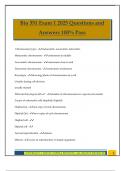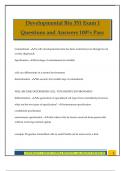EXAM GAME-CHANGER.
Here You Will Find All Exam Study Materials Offered By Seller SophiaBennett.
- 5543
- 0
- 373
Community
- Followers
- Following
10 Reviews received
5924 items

BIO 351 Bundled Exams 2025 Questions and Answers 100% Pass Guaranteed
BIO 351 Bundled Exams 2025 Questions and Answers 100% Pass Guaranteed
- Package deal
- • 21 items •
- BIO 351 midterm Exam Questions and Answers 100% Pass Updated 2025 • Exam (elaborations)
- BIO351: Development of the Peripheral Nervous System Exam 2025 Questions and Answers 100% Pass • Exam (elaborations)
- BIO 351 Module 7 Exam 2025 Questions and Answers 100% Pass • Exam (elaborations)
- BIO 351 FINAL EXAM 2025 QUESTIONS AND ANSWERS 100% PASS • Exam (elaborations)
- BIO 351 - Final Exam 2025 Questions and Answers 100% Pass • Exam (elaborations)
- And more ….
BIO 351 Bundled Exams 2025 Questions and Answers 100% Pass Guaranteed

Bio 351 Exam 1 2025 Questions and Answers 100% Pass
Bio 351 Exam 1 2025 Questions and Answers 100% Pass What are chromosomes made up of? - DNA packaged into chromatin telocentric - acrocentric - submetacentric - metacentric - karyotype - a complete set of chromosomes for an individual organism What do karyotypes tell us? - 1. the number of chromosomes is invariant within a species 2. there are two types of eukaryotic cells 3. the banding pattern of each type of chromosome is also variant 4. some chromosomes differ between the sexe...
- Package deal
- Exam (elaborations)
- • 8 pages •
Bio 351 Exam 1 2025 Questions and Answers 100% Pass What are chromosomes made up of? - DNA packaged into chromatin telocentric - acrocentric - submetacentric - metacentric - karyotype - a complete set of chromosomes for an individual organism What do karyotypes tell us? - 1. the number of chromosomes is invariant within a species 2. there are two types of eukaryotic cells 3. the banding pattern of each type of chromosome is also variant 4. some chromosomes differ between the sexe...

Bio 351 Exam 1 2025 Questions and Answers 100% Pass
Bio 351 Exam 1 2025 Questions and Answers 100% Pass Chromosome types - metacentric, acrocentric, telocentric Metacentric chromosome - centromere in middle Acrocentric chromosome - centromere close to end Telocentric chromosome - centromere at telomere Karyotype - drawing/photo of chromosomes in a cell Usually during cell division usually stained What do Karyotypes tell us? - number of chromosomes in a species (invariant) 2 types of eukaryotic cells (haploid/diploid) Haploid (n) - one ...
- Package deal
- Exam (elaborations)
- • 6 pages •
Bio 351 Exam 1 2025 Questions and Answers 100% Pass Chromosome types - metacentric, acrocentric, telocentric Metacentric chromosome - centromere in middle Acrocentric chromosome - centromere close to end Telocentric chromosome - centromere at telomere Karyotype - drawing/photo of chromosomes in a cell Usually during cell division usually stained What do Karyotypes tell us? - number of chromosomes in a species (invariant) 2 types of eukaryotic cells (haploid/diploid) Haploid (n) - one ...

Developmental Bio 351 Exam 1 Questions and Answers 100% Pass
Developmental Bio 351 Exam 1 Questions and Answers 100% Pass Commitment - A cell's developmental state has been restricted (even though its not overtly displayed) Specification - first stage of commitment (reversible) cells can differentiate in a neutral environment determination - the second, irreversible step of commitment WILL BECOME DETERMINED CELL TYPE DESPITE ENVIRONMENT differentiation - the generation of specialized cell types from committed precursors what are the two types ...
- Package deal
- Exam (elaborations)
- • 34 pages •
Developmental Bio 351 Exam 1 Questions and Answers 100% Pass Commitment - A cell's developmental state has been restricted (even though its not overtly displayed) Specification - first stage of commitment (reversible) cells can differentiate in a neutral environment determination - the second, irreversible step of commitment WILL BECOME DETERMINED CELL TYPE DESPITE ENVIRONMENT differentiation - the generation of specialized cell types from committed precursors what are the two types ...

BIO 351 Module 3 2025 Questions and Answers 100% Pass
BIO 351 Module 3 2025 Questions and Answers 100% Pass The neural tube forms from the folding of the neural plate. Which region of the neural tube is the first to close? - B The brain is derived from which of the following: - ectoderm The nervous system begins as a flat neural plate that runs along the midline from rostral to caudal. Folding is initiated with the [ Select ] anchored to the [ Select ] and changes shape while the epidermal cells move toward the dorsal midline. - medial hing...
- Package deal
- Exam (elaborations)
- • 5 pages •
BIO 351 Module 3 2025 Questions and Answers 100% Pass The neural tube forms from the folding of the neural plate. Which region of the neural tube is the first to close? - B The brain is derived from which of the following: - ectoderm The nervous system begins as a flat neural plate that runs along the midline from rostral to caudal. Folding is initiated with the [ Select ] anchored to the [ Select ] and changes shape while the epidermal cells move toward the dorsal midline. - medial hing...

BIO 351 Final Exam 2025 Questions and Answers 100% Pass
BIO 351 Final Exam 2025 Questions and Answers 100% Pass What is the cell wall component that members of bacteria have that members of archaea do not? - peptidoglycan Long spiral bacteria that form flexible helices and have endoflagella are called - Spirochete Which of the three main components of flagella crosses the components of the cell envelope - basal body Polysaccharides that compose capsules and slime layers are termed - glycocylax This group of organisms are largely known to exi...
- Package deal
- Exam (elaborations)
- • 7 pages •
BIO 351 Final Exam 2025 Questions and Answers 100% Pass What is the cell wall component that members of bacteria have that members of archaea do not? - peptidoglycan Long spiral bacteria that form flexible helices and have endoflagella are called - Spirochete Which of the three main components of flagella crosses the components of the cell envelope - basal body Polysaccharides that compose capsules and slime layers are termed - glycocylax This group of organisms are largely known to exi...

BIO 351 Exam 1 Questions and Answers 100% Pass
BIO 351 Exam 1 Questions and Answers 100% Pass Cyanobateria - fix carbon via photosynthesis Cyclic photosynthesis - results in production of ATP Plants were not "free" from the aquatic environment until - sperm no longer had to swim to the egg Which organism is correctly described - Chara: nonmotile, multicellular Which one is correct? of lycophyta:1n b.Megaspores of isolates: 2n c. leaf like structures of mosses: 1n d microspore: 2n - leaf like structures of mosses: 1n which ...
- Package deal
- Exam (elaborations)
- • 4 pages •
BIO 351 Exam 1 Questions and Answers 100% Pass Cyanobateria - fix carbon via photosynthesis Cyclic photosynthesis - results in production of ATP Plants were not "free" from the aquatic environment until - sperm no longer had to swim to the egg Which organism is correctly described - Chara: nonmotile, multicellular Which one is correct? of lycophyta:1n b.Megaspores of isolates: 2n c. leaf like structures of mosses: 1n d microspore: 2n - leaf like structures of mosses: 1n which ...

Genetics BIO-351 Test #1 2025 Questions and Answers 100% Pass
Genetics BIO-351 Test #1 2025 Questions and Answers 100% Pass A ___________ is a sequence of nucleotides that are basic units of biological information. - Gene ___________ is the science of heredity and it seeks a precise explanation of the biological structures and mechanisms that determine what is inherited and how it is inherited. - Genetics ___________ is the purposeful control over mating by choice of parents for the next generation. - Artificial Selection ___________ is the proces...
- Package deal
- Exam (elaborations)
- • 29 pages •
Genetics BIO-351 Test #1 2025 Questions and Answers 100% Pass A ___________ is a sequence of nucleotides that are basic units of biological information. - Gene ___________ is the science of heredity and it seeks a precise explanation of the biological structures and mechanisms that determine what is inherited and how it is inherited. - Genetics ___________ is the purposeful control over mating by choice of parents for the next generation. - Artificial Selection ___________ is the proces...

BIO 351 Test #2 2025 Questions and Answers 100% Pass
BIO 351 Test #2 2025 Questions and Answers 100% Pass population genetics - changes in relative abundance of genetic variants in a population can be tied to changes in relative abundance of genetic variants that influence them evolution - change across generations in the frequencies of alleles population - group of interbreeeding individuals and their offspring gene pool - all of the different genes in an interbreeding population genetic drift - decline of the relative frequency of a geno...
- Package deal
- Exam (elaborations)
- • 4 pages •
BIO 351 Test #2 2025 Questions and Answers 100% Pass population genetics - changes in relative abundance of genetic variants in a population can be tied to changes in relative abundance of genetic variants that influence them evolution - change across generations in the frequencies of alleles population - group of interbreeeding individuals and their offspring gene pool - all of the different genes in an interbreeding population genetic drift - decline of the relative frequency of a geno...

Genetics BIO351 Tests #3 2025 Questions and Answers 100% Pass
Genetics BIO351 Tests #3 2025 Questions and Answers 100% Pass The step in DNA replication in which the replication proteins open up the double helix and prepare for complementary base pairing is called - Initiation The protein that progressively unwinds DNA ahead of each replication fork is called: - Helicase Assume that a wild-type sequence is 5'AGCCTAC3'. Indicate the sequence that might be produced by a transversion - 5'ATCCTAC3' Assume that the mutation rate for a given g...
- Package deal
- Exam (elaborations)
- • 6 pages •
Genetics BIO351 Tests #3 2025 Questions and Answers 100% Pass The step in DNA replication in which the replication proteins open up the double helix and prepare for complementary base pairing is called - Initiation The protein that progressively unwinds DNA ahead of each replication fork is called: - Helicase Assume that a wild-type sequence is 5'AGCCTAC3'. Indicate the sequence that might be produced by a transversion - 5'ATCCTAC3' Assume that the mutation rate for a given g...

NOCTI EOPA Study Guide with 100% Correct Answers
AV TECH EOPA review guide with Complete Solutions
Jersey College Sociology Final Exam Study Guide with Complete Solutions
CFESA GAS REVIEW QUESTIONS WITH 100% CORRECT ANSWERS
There is not all the questions on here. There is only 15 questions not 100.
HMX Physiology Exam Study Guide with Complete Solutions